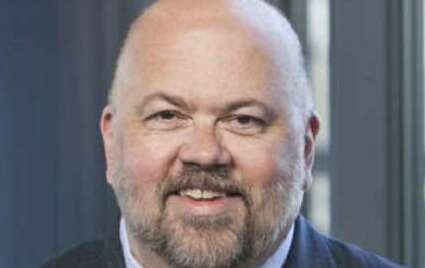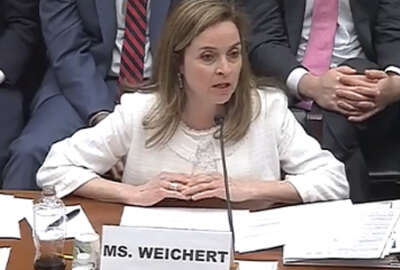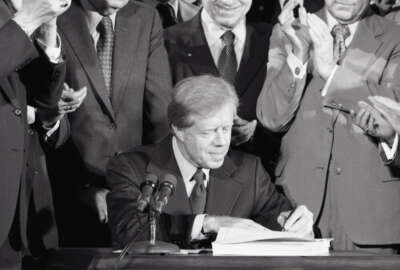
What happens next with OPM?
The administration's proposal to revamp OPM would not be the death-knell of the Civil Service. In fact, Commentator Jeff Neal said let's try the approach. If it...
Best listening experience is on Chrome, Firefox or Safari. Subscribe to Federal Drive’s daily audio interviews on Apple Podcasts or PodcastOne. This column was originally published on Jeff Neal’s blog, ChiefHRO.com, and was republished here with permission from the author.
The recent news that Office of Personnel Management (OPM) Director Jeff Pon had been forced out after only seven months on the job was quite a shock to the federal HR community. Pon is a longtime HR professional, having served in the past in key positions at OPM and as chief human capital officer for the Department of Energy. His combination of government HR experience, combined with private sector HR experience at the Society for Human Resources Management, made him the most technically qualified director OPM has had in its 40 year history.
So what happened? Neither the White House nor Pon are speaking publicly about the details, but sources close to Pon are telling reporters (such as Eric Yoder and Lisa Rein of The Washington Post), that Pon was “at odds with the administration over its planned revamp of the personnel agency, which would have diminished his role and authority.” Nothing I have heard contradicts that view. In my own conversations with Jeff before his departure, it was clear that he believed some aspects of the administration proposal to reorganize the work of OPM into GSA and the White House (and possibly other agencies), would require congressional approval. For example, OPM was created by the Civil Service Reform Act of 1978. Federal law (specifically 5 U.S. Code § 1101) says “The Office of Personnel Management is an independent establishment in the executive branch.” In other parts of the United States Code, authority over contracting for the Federal Employees Health Benefits Program rests with OPM, along with various other aspects of OPM’s mission.
You may be thinking: “What is an independent establishment?” Could that be an office within the Executive Office of the President, as the administration has proposed? Probably not. 5 U.S. Code § 104 defines an Independent Establishment as “an establishment in the executive branch (other than the United States Postal Service or the Postal Regulatory Commission) which is not an Executive department, military department, Government corporation, or part thereof, or part of an independent establishment.” The number of laws that reference OPM as the agency with authority over a wide variety of civil service-related matters makes it unlikely that OPM could be eliminated by executive action.
The proposal to revamp OPM
The fact that eliminating OPM would require congressional approval does not mean that many aspects of the administration’s reorganization proposal cannot be implemented. As a reminder, here are some of the key provisions of the proposal:
- Move fee-for-service work from OPM’s Human Resources Solutions (HRS) group to the General Services Administration. HRS provides services such as training, executive development (including OPM’s excellent Federal Executive Institute), software (including USAJobs, USA Staffing, USA Performance, and others), and consulting services in a wide range of human resources disciplines. Their money is in a working capital fund. Moving working capital funds is complicated, but it is doable. There may be details related to specific OPM authorities, but much of the work HRS does is also work that agencies can do on their own, or that OPM can delegate to agencies. It is likely that such issues can be addressed successfully.
- Move background investigations to the Department of Defense. Like the HRS work, this is primarily a working capital fund activity and there does not appear to be any statutory requirement that it remain in OPM. In fact, the 2018 National Defense Authorization Act gave DoD the authority to conduct its own background investigations (about 70 percent of OPM’s background investigation workload). My own belief is that this work is such a distraction to OPM that the agency would be better off without it.
- Move insurance and retirement programs to GSA or another agency and move civil service policy to the Executive Office of the President. These are much more difficult to do. The Civil Service Reform Act clearly established OPM as the principal human resources agency for the federal government. Key provisions include designating OPM as “an independent establishment in the executive branch” and making the OPM director responsible for “executing, administering, and enforcing the civil service rules and regulations of the President and the Office and the laws governing the civil service; and the other activities of the Office including retirement and classification activities; except with respect to functions for which the Merit Systems Protection Board or the Special Counsel is primarily responsible.” The OPM director is also charged with “aiding the President, as the President may request, in preparing such civil service rules as the President prescribes, and otherwise advising the President on actions which may be taken to promote an efficient civil service and a systematic application of the merit system principles, including recommending policies relating to the selection, promotion, transfer, performance, pay, conditions of service, tenure, and separation of employees.”
More than half of OPM is funded by working capital funds and is not specifically required by law to exist in its current form. That means there is considerable leeway in how and where the work is done. It is likely that movement of the working capital fund activities to DoD and GSA is within the authority of the executive branch. The core insurance, retirement and civil service policy and oversight work appears to be established in law as a responsibility of OPM. It is far more difficult to untangle all of those legal authorities and push them to other agencies. That does not mean there are not options that could work.
Although the president does not have authority to unilaterally disestablish federal agencies, he does have considerable authority over the Executive Office of the President (EOP). It is possible that the administration could establish an office within EOP that plays a significant role in civil service policy, with OPM continuing to exist much as it does now. Such an office would play a role similar to the Office of Federal Procurement Policy (OFPP) and its relationship with GSA, DoD and NASA in overseeing procurement policy. As GSA describes the process, “The Federal Acquisition Policy Division writes and revises the FAR. The Division coordinates with the Office Federal Procurement Policy and other agencies in a highly collaborative and deliberative process to implement laws, executive orders, other agency regulations, and governmentwide policies to support the maintenance of the FAR.” OFPP is authorized by statute and has a Senate-confirmed director.
While the Civil Service Reform Act designates the OPM director as the president’s principal adviser on civil service policies, there does not appear to be anything that grants it exclusivity. An arrangement similar to that used for procurement policy could work for civil service policy as well and may be consistent with the Civil Service Reform Act provision granting OPM authority to advise the president on civil service matters. For that type of arrangement to have any longevity beyond the current Administration, it would eventually have to be codified in law.
Feds as political footballs
So what would happen if civil service policy was more overtly controlled by the White House? Would it wreck the merit system and politicize the civil service? Would ripping away the facade of nonpartisanship in civil service policy accelerate the decline of the civil service? Maybe, but that idea assumes civil service policy is apolitical. Who does not think civil service politicized has been politicized already? Federal workers have been used as political footballs for so long that we should stamp Wilson on their foreheads. Here are the facts:
- The OPM director and deputy director are Senate-confirmed presidential appointees.
- The director is appointed to a four-year term, but both officials serve at the pleasure of the president.
- As chief executive, the president gets to make policy to the extent that it is neither proscribed nor required by law.
- OPM does not make major policy decisions in a vacuum
- Any major civil service policy initiative it undertakes is done in coordination with the White House (specifically with the Office of Management and Budget).
Rather than pretending that there is no political aspect to civil service policy, one could argue that it would be better to get that political aspect of it out in the open. Are there benefits? Maybe. The chief complaint against OPM is that it is slow and unresponsive to agency needs. Former Director Pon even joked that he did not want it to be viewed as NoPM or SlowPM. My experience as a CHCO taught me that OPM has some real strengths and some real weaknesses. The strengths include some of the segments that might be realigned to GSA. The executive development work, in particular, is quite good. The Federal Executive Institute is highly regarded and offers exceptionally good training. OPM’s administration of health and life insurance is also excellent. I also learned that some parts of OPM’s policy shop and general counsel’s office were very OPM-focused on everything, and wanted a one-size-fits-all approach to matters where that approach did not work. Do we really want the same 80-day hiring model for a WG-5 Materials Handler, a GS-14 Cyber Security expert, a GS-15 Research physicist, and a Secret Service Agent? When I explained that the American people wanted DHS to have the right people for our cyber security mission and to keep air travel secure, I was told that what the American people want most is a civil service that follows merit system principles. The idea that those requirements are in conflict was maddening. Rules do not equate to merit and merit does not require that every hiring manager be treated as though s/he wants to hire their cronies.
Maybe more White House direction would speed the pace of reforms in the civil service and drive OPM to use its rule-making authority for hiring and other critical processes. Acting Director Margaret Weichert’s announcement last week of expanded direct hire authority and pay flexibility is a good start. The pay flexibility is an authority OPM has had for years, but not used. It is not the only authority OPM has sat on. When I was at DHS and asked OPM for critical position pay authority for a key job, the first response was that OPM did not like to use that authority. It had existed for 20 years and allowed up to 800 positions governmentwide, but OPM had granted it for fewer than 30 jobs. OPM does not have a history of moving out quickly on policy issues.
That leads to the real problem that many folks have with this proposal. They don’t like what they think this particular White House would do with it. Change the party controlling the White House, and the Republicans would not like the way they think the Democrats would handle it. We apparently think White House control is OK when our party runs everything, but not when the other guys do. The illusion of OPM as an independent guardian of the merit system is reassuring to some.
Don’t eliminate things OPM does well
I think the idea of OPM as an independent entity that is just running a merit-based civil service is not real. If that were true, I would argue that anything that appears to politicize the civil service should be avoided at all costs. The civil service is what makes the government work, and it is where tremendous amounts of institutional and technical knowledge reside. We do not need anything to jeopardize that. But, OPM is not an independent entity that is free from political involvement and it was not structured by the CSRA to have any kind of bipartisan leadership structure. It has political leadership now and has since it was created.
Clearly the White House wants more overt control over civil service policies. Following the OFPP/GSA model is something that could probably be executed effectively and might, if done well, actually improve civil service policymaking. OPM takes too long to go from idea to published policy. It tends to be only partly responsive to agency needs. A policymaking board comprising a combination of an office in the EOP, OPM, and representatives from the departments and large independent agencies, might be able to drive workforce policies in a more effective manner. Such an arrangement would also make it less likely that White House involvement in civil service policy would result in politicizing the civil service any more than it has already been politicized. It would also ensure that civil service policy was driven by what is needed for talent management in government and not just by what sells politically. The director of OPM is established in law by 5 U.S. Code § 1102, which says: “No individual shall, while serving as Director or Deputy Director, serve in any other office or position in the Government of the United States except as otherwise provided by law or at the direction of the President.” That means the president could establish an office within EOP with the director of OPM dual-hatted as its director. Doing so would accomplish the administration’s stated goal of elevating the role of the OPM director. Another option would be to grant Cabinet status to the director of OPM as President Clinton did.
The last thing we need to keep in mind is that OPM is not the primary guardian of the merit-based civil service. The real guardian is Congress. The merit system principles are not OPM regulations — they are law. The prohibited personnel practices are law. The protections from removal without due process are law (and constitutional). Reorganizing OPM or creating the civil service equivalent of OFPP does not change that.
We have had 40 years of OPM as it currently exists. Before that we had 93 years of the Civil Service Commission (not counting the 2 years the CSC existed in the 1870s). Neither OPM nor the Civil Service Commission were perfect and both had their critics. Is the administration’s proposal what I would choose if it were up to me? Probably not. Is it the death knell of the Civil Service? No. As a matter of fact, having civil service policy reside in EOP was one of the approaches that was considered in writing the Civil Service Reform Act of 1978.
I say let the administration try their proposed arrangement. If it works, Congress can codify it and make it permanent. If not, Congress can more clearly codify the role of OPM and undo it. There is little likelihood that it will create any problems that cannot be fixed.
Jeff Neal is a senior vice president for ICF and founder of the blog, ChiefHRO.com. Before coming to ICF, Neal was the chief human capital officer at the Homeland Security Department and the chief human resources officer at the Defense Logistics Agency.
Copyright © 2024 Federal News Network. All rights reserved. This website is not intended for users located within the European Economic Area.






